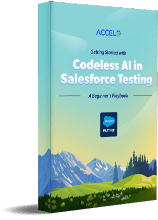Salesforce testing with a Codeless AI test automation platform ACCELQ
Salesforce test automation is an automated testing process that can efficiently handle the advanced complexities of the Salesforce application. The Selenium testing framework is usually a popular choice for automating Salesforce testing; since it comes with benefits which are listed below. Let us note that since Salesforce pages are dynamic in nature, coming up with a robust Salesforce test automation framework can be a challenge. That said, Salesforce automation testing with Selenium also comes with certain limitations that can exacerbate more such challenges.
Benefits of Salesforce automation testing with Selenium
Selenium is a language independent tool and hence Selenium scripts written in Java, Python, C# etc., can be run on multiple operating systems like Windows, MacOS, Linux etc. Selenium also offers various third-party drivers and plugins that make it highly capable of testing complex web-based technologies like Salesforce. Further:
- Selenium can be modified according to their needs.
- It provides robust community support through its large network of users.
- It allows for many integration options that enable things like parallel testing and reporting.
- Selenium frameworks with the right design increase test coverage and save time.
While Salesforce automation testing with Selenium could be popular it is not necessarily the most efficient option. Selenium demands advanced coding skills to write tests, and it doesn’t work very well with shadow DOM, making it unreliable in many cases. Using Selenium for Salesforce test automation is ridden with multiple other challenges and does not guarantee reliable, scalable results while efficiently managing the resources of QA teams. A robust Codeless AI Salesforce test automation framework can do away with limitations of traditional testing tools, like Selenium web driver, QTP, UFT, etc.
Salesforce Test Automation in Shifting Landscape
A Beginners’ Guide
Salesforce Test Automation with Codeless Tools other than Selenium:
Codeless test automation tools can add agility to the Salesforce test automation process while effectively increasing the testing footprint. Given the complexities of Salesforce testing, developing these capabilities helps improve test automation outcomes while reducing effort. Allow us to list a few.
| 1. | Easy to create tests- it is faster error- free and agile since test creation does not require scripts. |
| 2. | Testing reliability as even non-technical users can carry out Unit testing, UAT, System testing, Production, and Regression testing. All this is needed is an understanding of business logic. |
| 3. | Offer pre-built Codeless Test Assets with real-time Salesforce release alignment. |
| 4. | Help in the automation of all core business processes and objects |
| 5. | Enable continuous testing addressing all functional and API related testing needs with auto-generation of test cases and enhance the quality in testing life cycle. |
| 6. | Drive end-to-end validation by testing Salesforce UIs and APIs in the same flow without any programming needs. |
However, it is important to evaluate the codeless tools ecosystem and ensure that these are optimized to meet the needs of the dynamic elements of Salesforce. An AI-driven codeless test automation tool can be optimized to deliver on this front and enable robust test automation for Salesforce-specific dynamic technology. Managing dynamic elements & iframes test automation becomes simpler, easier, and faster.
ACCELQ for Salesforce Test Automation:
ACCELQ is a leading Continuous Testing platform, deeply aligned with Salesforce to accelerate and improve the quality of your Salesforce releases significantly. ACCELQ for Salesforce test automation adopts a lightning-fast & easy testing approach, just like Salesforce!
- Salesforce Release Alignment: Being an ISV partner, ACCELQ is aligned to Salesforce releases to ensure smooth Salesforce upgrades with robust Automation testing
- Codeless Salesforce automation of Web, Mobile & API: Easily automates end-to-end flows in an integrated Salesforce environment from Web-API-Mobile. AI-driven no-code test automation on cloud optimized for Salesforce-specific Dynamic technology.
- Accelerates Salesforce test automation: With pre-defined Codeless Salesforce test assets with real-time Salesforce release alignment.
- On Salesforce AppExchange: ACCELQ is the only cloud-based Continuous testing and automation platform on Salesforce AppExchange.
| Salesforce Architecture |
|
|---|---|
| Salesforce Offerings |
|
| Diverse Technology Stack |
|
Conclusion
ACCELQ is a game-changer in the realm of Salesforce test automation. Its codeless approach, coupled with AI-driven capabilities, simplifies the testing process and enhances its effectiveness. For readers navigating the complexities of Salesforce testing, ACCELQ presents a compelling solution. Take the next step to advance your Salesforce test automation benefits by discovering the benefits of codeless AI-powered Salesforce test automation.
Geosley Andrades
Director, Product Evangelist at ACCELQ
Geosley is a Test Automation Evangelist and Community builder at ACCELQ. Being passionate about continuous learning, Geosley helps ACCELQ with innovative solutions to transform test automation to be simpler, more reliable, and sustainable for the real world.
Discover More
 Enterprise Test Automation: Comprehensive Guide
Enterprise Test Automation: Comprehensive Guide
Enterprise Test Automation: Comprehensive Guide
 What Is Oracle Test Automation
What Is Oracle Test Automation





